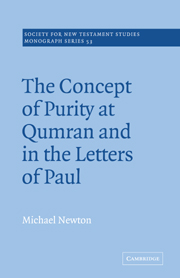Book contents
- Frontmatter
- Contents
- Acknowledgements
- List of abbreviations
- 1 Introduction
- 2 The concept of purity in the Qumran community
- 3 Purity and the cult in the letters of Paul
- 4 Purity and membership of the Church
- 5 Purity and the continuing life of the Church
- 6 Conclusion
- Notes
- Bibliography
- Index of passages cited
- General index
3 - Purity and the cult in the letters of Paul
Published online by Cambridge University Press: 10 December 2009
- Frontmatter
- Contents
- Acknowledgements
- List of abbreviations
- 1 Introduction
- 2 The concept of purity in the Qumran community
- 3 Purity and the cult in the letters of Paul
- 4 Purity and membership of the Church
- 5 Purity and the continuing life of the Church
- 6 Conclusion
- Notes
- Bibliography
- Index of passages cited
- General index
Summary
Introduction
Much of Paul's use of purity terminology centres upon his view that the believers constitute the Temple of God and as such enjoy the presence of God in their midst. In order to retain this presence (expressed variously as ‘God's Holy Spirit’, ‘God's Spirit’, ‘Christ’) this Temple must remain pure. This means that its members, the individual believers, must preserve strict standards of behaviour. Immorality results in an impurity which is unacceptable to God's presence. In his correspondence with the Churches in his charge, Paul strives to uphold conduct befitting those who would wish to maintain their membership in the Temple of God. In his letters Paul reveals an awareness of the inter-connection of sinful behaviour, uncleanness and the requirements for God's continued presence among his people. He uses the language of the Jewish cult which, centred as it was upon the Temple in Jerusalem, sought to ensure that the holy precincts were not contaminated by the entrance of those considered impure (Num. 19:13; M. Kelim 1.8) nor polluted by the wanton sins of the people. The continued presence of God in the sanctuary depended on the maintenance of the purity of the sanctuary and its surroundings. Wanton sinners were excluded and the impurity with which their sins polluted the sanctuary was removed by the expiatory blood rites (Lev. 16:16f.).
- Type
- Chapter
- Information
- Publisher: Cambridge University PressPrint publication year: 1985



